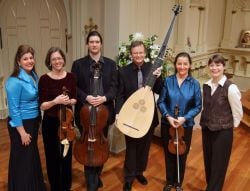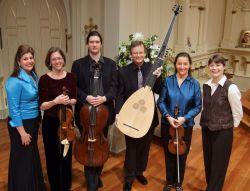
It would have been hard to tell, observing the small, graying audience in St. Mark’s Lutheran Church in San Francisco on Saturday, that videos of the early-music band Voices of Music had received, as of this writing, 3,558,070 hits on YouTube. I suspect a good deal of those came from Web queries for the famous Pachelbel Canon, of which VOM has posted an excellent recording.
Digital media, of course, are often doctored. For those on the interwebs curious whether VOM’s live performance is the real thing, the answer is yes. Led by Hanneke van Proosdij (harpsichord and recorder) and David Taylor (archlute), the ensemble draws from the Bay Area’s top-tier performers. Saturday’s concert included Laura Heimes (soprano), Carla Moore and Sara Usher (violins), Katherine Heater (keyboards), Farley Pearce (cello), and John Dornenburg (violone) playing works of Corelli, Handel, and Scarlatti. Rather than invent some outreach-gimmick, VOM simply films what early music performers already do and puts it onto the Web with minimal editing. In essence, this is an evolution of the explosion of the early-music recording industry since the 1980s.
The recent attribution to Handel of a setting of Gloria in excelsis, which VOM performed, has sparked worldwide interest and a flurry of renditions of the piece for soprano, violins, and continuo. With its brilliant coloratura (fast vocal lines on a single syllable), I suspect it will become a popular alternative to Bach’s similarly showy solo Cantata No. 51. On Saturday, soprano Heimes sang the Gloria with flair, perfection, and a gorgeously clear yet warm and feminine tone. Mindful of the Webcams capturing the event, she also sported a stunning, pleated magenta dress. It is easy to categorize singers excelling in this music as specialists. Heimes would sound lovely in other repertory, but mostly on recording. For singers, clarity of tone often comes at a sacrifice of volume.
Singing Naturally, Then and Now
In a sense, singing early music is much like singing popular music. In the 19th century, as concert halls and theaters grew in size to accommodate a new middle class audience, musical and singing styles evolved to fill these cavernous spaces. With the invention of the microphone, popular singing and musical styles changed yet again. With a mic, little details in phrasing could come across, much as acting styles moved away from vaudeville overexaggeration toward subtle gesture on film. Yet beauty and clarity associated with early-music specialists is part and parcel of the artistry of cabaret artists, crooners, and pop idols such as the early Whitney Houston.
I am always delighted to hear Baroque cantatas such as Heimes’ excellent rendition of Alessandro Scarlatti’s Bella madre de’ Fiori: Modern audiences typically hear only an instrumental subset of Baroque music, even though music of that era was overwhelmingly vocal. Instrumental works such as Arcangelo Corelli’s Sonata in F, Op. 5, No. 4, which VOM also performed, were published to be adaptable for performance on flute or violin with any type of accompaniment, much as songs published today usually include guitar tabs in addition to a piano part. I am sure the Web video will pick up van Proosdij’s smile of satisfaction with her performance on recorder of the sonata. She should be satisfied. She performed the work Saturday with tricky ornaments published by John Walsh in 1707. The work, with many blazing fast passages, might as well be called The Devil’s Recorder. There is debate whether the ornaments are actually by Corelli, but this is unimportant. The real question to ask is whether they are good: They are.
I do not see much of a garage-band phenomenon of young players throwing together early music. This strikes me as odd, because it seems that an archlute would look as cool to any teenager as a trumpet or electric guitar. Improvising Baroque music on a harpsichord is a lot closer to playing Tori Amos or Ray Charles than it is to playing Brahms. Would school music programs be more popular if teenagers were handed Baroque fiddles and asked to make up their own riffs in the Pachelbel Canon? With almost four million Internet hits, Voices of Music might be on to something.

